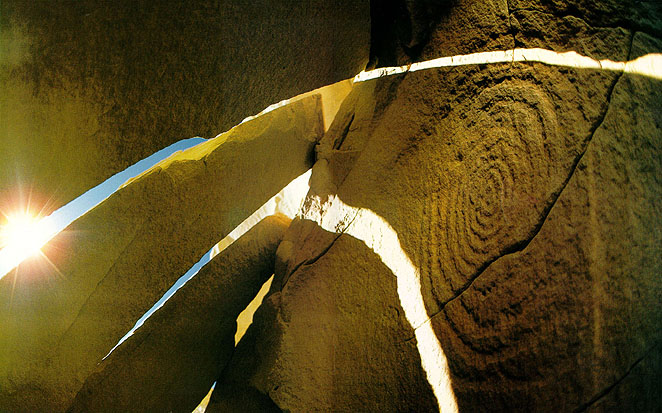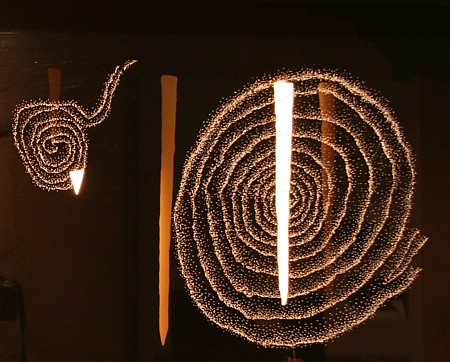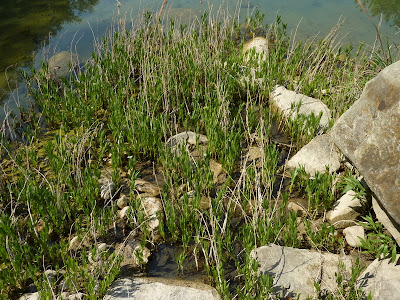 |
| Notice the obvious here? |
 |
| Deeper into Priest Cave. |
A few days ago we posted an entry which featured some of these cave photographs. At the time we thought the cave might have been the home of a mountain lion. Perhaps we were wrong. After careful study and research of some big books, we are ready to announce the discovery of an ancient Priest's Cave. We now refer to it as "Priest's Cave" instead of "the hole in the boulders where a cougar might have stayed."
One of the first clues is the presence of what we call a "sun dagger." You can see it in the photo below.
 |
| Could a mountain lion REALLY be responsible for this? Hardly. Priests of an ancient cult remain our only answer. |
Though we are prepared to accept some coincidences as merely coincidences (like having not only ONE Negro living in the White House now, but FOUR Negroes and all at the same time), careful investigation of the following data leads us to a profound conclusion. Data to consider:
- The angles of dark black lines superimposed on the photograph above match those in the map below.
2. Notice the ley lines in the map below. If you follow each line real close, you will see that it eventually meets up with EVERY OTHER LINE. And the point at which they all meet is EXACTLY at the spot where the Priest's Cave is. If only one of the ten lines had gone off in another direction, we would have been skeptical. But EVERY SINGLE LINE without exception converges at the one spot on the globe where the Priest's Cave is.
Here's what we read about ley lines from a scholarly website (http://www.angelfire.com/in/RajunasRefuge/leylines.html):
Alfred Watkins, discovered leylines in 1921 from his realization that a series of straight lines could link all of the Earth's various landmarks into a network of ancient tracks. "Watkins believed that this alignment could not be due to mere chance. He believed that prehistoric man had deliberately made the tracks as a sort of road network, using the various landmarks as sighting points. Many of them are situated on hilltops where they could be seen against the horizon, and thus made excellent reference points for the Neolithic or Bronze Age traveller. He first voiced his discoveries in public at a slide-show and lecture to fellow members of the Woolhope Club where, although treated with some scepticism, they were well received and aroused keen interest.
3. Though there are plenty of other caves on the property, any of which COULD HAVE been the Priest's Cave, this is the ONLY one that is. In other words, it is the ONLY cave with a sun dagger and the uncanny angles.
4. There is great consistency with this theory and that which is held by many other scholars. Below is an excerpt from one of these scholars. You can find more that he has written on the subject of Ley Lines at his website:
http://www.vortexmaps.com
[you really have to see this website to appreciate what we are doing here]
"Vortices appear to be points of power or energy on the Earth, and ley lines are the relationships between those points. An analogy might be that the vortices are accupressure points. and the ley lines between them are meridians on the skin of the body of Mother Earth.
However, reality is likely not so simple. My theory is that there is a template for this physical reality in a world existing concomitant with this one, and that template is geometric, or mathematical in organization. Matter is here, then not here, moving back and forth between implicate and explicate reality, as described in the theories of David Bohm, a contemporary and colleague of Einstein. This template for matter as we experience it in this explicate reality (the physical world) is in implicate reality, as also described in the "morphogenetic fields" of Rupert Sheldrake, a biologist at Cambridge in the 1960's.
2Joel Goldsmith, a metaphysical healer, often alludes to the same kind of system in his books, Jane Roberts mentions It in the Seth books, and Swedenborg Wrote of the correspondence between this world and that of the spiritual in Heaven and Hell, paragraph 90.
If this is what is, then it's possible that the template for our Earth 'in that unseen reality is crystalline 'in organization. Furthermore, that crystalline matrix seems to be similar to a geodesic dome--a series of triangular shapes fit together to form the skin of a sphere. The joining on the surface of the Earth at the apexes of these triangles are points of energy focus, the vortices of the Earth. Some of the principal lines of force Join -mg these vortices, called "ley lines, " form triangular shapes between vortices.
At these foci of energy Earth, as it forms 'in explicate reality (our world as we sense it), reveals the presence of these foci, or vortices, by -nations of geologic significance: These formations are volcanoes, high mountains, hot springs, mineral deposits, ends of sand spits near the ocean, sea mounts, forks of rivers, river mouths, large falls, deep gorges, rock outcroppings, and possibly others. Some dams are located on vortices, and often mineral deposits, especially gold, denote a vortex. There is a whole swirl of vortices around and near the Golden Gate Bridge, and these might be the coming together of several faults--many ley lines follow the great faults and waterways on the surface of our earth.
This system of vortices and ley lines is not a new idea. Sacred temples of the ancient world around the Mediterranean are located at powerful vortices, and drawing lines between them will bring out patterns of triangles. The Indians in the American Southwest as well as those in Peru and other parts of South America located their cities and the roads between them on vortices and ley lines, which look Like so many spokes and hubs. The Chinese practice the ancient science of geomancy. "The Olde Straite Pathes" of England,
3 the location of Stonehenge and it's relationship to the Great Pyramid, Glastonbury and the myth of Avalon correlate to vortices. I'm sure there are many more examples throughout the world."
Carefully read that last line. Yes, here at Priest Cave we have another example of the sacred ley lines. Ancient Indians came over Here a long time ago. Some of them settled in the mountain lion's den because they recognized the sun dagger.
Below are some photographs of another sun dagger. This one is in Chaco Canyon or somewhere like that. If the ancient Indians who came to our Priest Cave knew of the other sun dagger, then their settlement here is all the more striking. But if they did NOT know about the other sun dagger, how did they recognize THIS sun dagger? Either way, the fact is truly mysterious.
http://www.angelfire.com
"The Sun Dagger site, near the top of Fajada butte, revealed the changing of the seasons to Anasazi astronomers a thousand years ago. Its secret was lost around 1250 AD, when the ancient people abandoned Chaco Canyon. Then in 1979, an artist was studying petroglyph art at Chaco when she noticed that a slender beam of sunlight passing between two rock monoliths bisected the center of a spiral-shaped symbol on the exact day of the summer solstice."

 |
Notice that this cave nearby Priest Cave has none of the hallmark signs of mystery.
No sun dagger. No uncanny angles. Complete absence of religiously-placed rocks.
A clear contrast. |
The following was copied from another reputable website. Please study what it has to say about ley lines, too.
http://home.hiwaay.net/~jalison/index.html
"The relationship between the distances from Angkor Vihear to the Great Pyramid and from the Great Pyramid to the Nazcan Hummingbird is also a precise expression of φ:
4,754 x 1.618 = 7,692
Because the Hummingbird and Angkor Vihear are antipodal sites, with a distance between them of one-half of the circumference of the earth, two Golden Section relationships between these three sites are shown by the circumference of the earth along the line of ancient sites:
4,754 x 1.618 = 7,692
4,754 + 7,692 = 12,446, and
7,692 x 1.618 = 12,446
These Golden Section relationships may also be diagramed on a straight line:
The line of ancient sites is a line, from the perspective of the first illustration in Part One, and it is a circle, from the perspective of the azimuthal projection above. The line and the circle are found in the greek letter φ and the number 10. Zero and one are also the first two numbers and the only two numbers in the binary code.
The
φ relationships between these sites are reflected repeatedly in
the first 500 Fibonacci numbers. The first three prime numbers, 2, 3 and 5, approximate the intervals along the circumference of 20%, 30% and 50%, between these three sites. This same percentage of the circumference relationship, accurate to three digits, is found in Fibonacci numbers 137-139:
| Percentage of circumference: | First three digits of Fibonacci numbers: |
| Angkor to Giza: 19.1% | #137: 191... (Prime) |
| Giza to Nazca: 30.9% | #138: 309... |
| Nazca to Angkor: 50.0% | #139: 500... |
The next prime Fibonacci number after #137 is #359. The distances between these sites, in miles, is reflected by Fibocacci numbers 359-361, accurately to five digits:
| Distance between sites: | First five digits of Fibonacci numbers: |
| Angkor to Giza: 4,754 miles | #359: 47542... (Prime) |
| Giza to Nazca: 7,692 miles | #360: 76924... |
| Nazca to Angkor: 12,446 miles | #361: 12446..." |
We will continue to explore Priest Cave and post our findings as we know more.




































